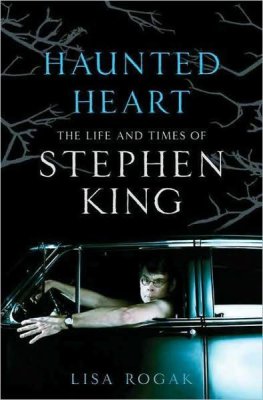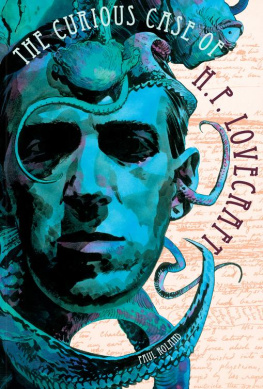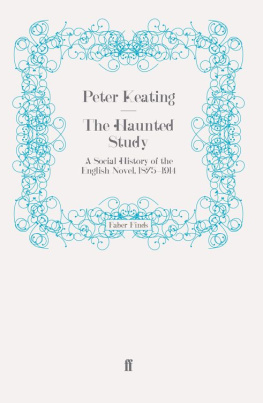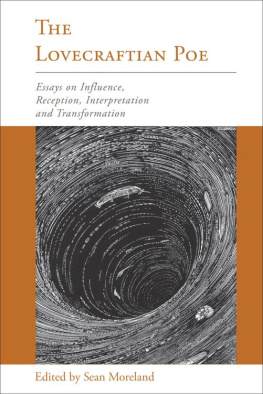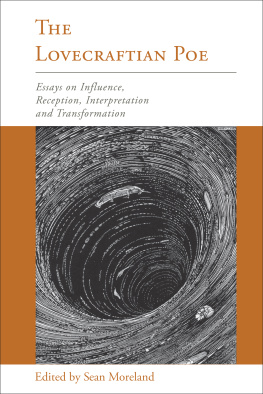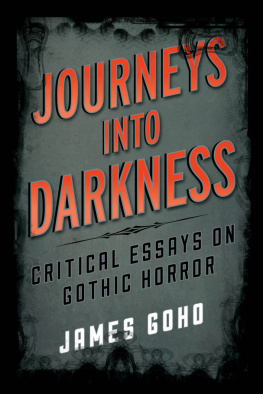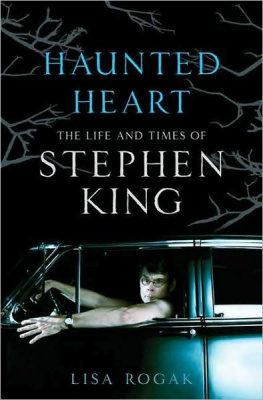
The Literary Haunted House
Lovecraft, Matheson, King and the Horror in Between
Rebecca Janicker

McFarland & Company, Inc., Publishers
Jefferson, North Carolina
LIBRARY OF CONGRESS CATALOGUING DATA ARE AVAILABLE
BRITISH LIBRARY CATALOGUING DATA ARE AVAILABLE
e-ISBN: 978-1-4766-1928-6
2015 Rebecca Janicker. All rights reserved
No part of this book may be reproduced or transmitted in any form or by any means, electronic or mechanical, including photocopying or recording, or by any information storage and retrieval system, without permission in writing from the publisher.
Front cover image 2015 Antonis Liokouras/iStock/Thinkstock
McFarland & Company, Inc., Publishers
Box 611, Jefferson, North Carolina 28640
www.mcfarlandpub.com
This book is dedicated to Lincoln
Acknowledgments
This book began as a Ph.D. project at the University of Nottingham and there are several members of the academic staff there whom I must thank for their guidance and support. My original supervisor, Peter Messent, deserves acknowledgment and gratitude for all his work towards shaping and guiding the project early on. Special thanks go to Nick Heffernan, who later took over that role and whose constructive feedback and encouragement helped steer the project to completion. I also offer thanks to my Ph.D. examiners, Matthew Pethers and Lorna Jowett, as well as to all those staff members and Ph.D. students who participated in the Work in Progress seminars that I undertook as part of my studies.
Beyond the University of Nottingham, there are several other academics for whose expertise and support I wish to express my gratitude. Having been a regular presenter at the annual National Popular Culture/American Culture Conference since undertaking the Ph.D., I would like to thank the area chairs, co-presenters and panel-attendees for the Gothic, Horror and Stephen King Areas at these events. This opportunity to share my research, receive constructive criticism and simply to discuss my scholarly interests with like-minded researchers over the years has been invaluable. For their support in providing funding for my participation in these conferences, I would like to thank the Centre for Cultural and Creative Research at the University of Portsmouth. Having been a part-time lecturer at that university since 2005, and a permanent lecturer since 2009, I have many supportive colleagues there to thankespecially in the School of Creative Arts, Film and Mediaand have also made some good friends. In particular, for their various contributions, I wish to thank Emma Austin, John Caro, Imogen Jeffrey, Van Norris, Deborah Shaw, Esther Sonnet, Graham Spencer and Jackie Walker.
Heartfelt thanks go to my family, whose practical and emotional support helped me to continue with what has been, at times, a very challenging endeavor. Many, many, many thanks go to my parents, Laurie and Kathy Janicker, as well as to Diane and to Malcolm Geraghty. Far and away the deepest thanks go to my husband Lincoln Geraghty, whose editorial skills, general ability to lead by scholarly example and, above all, love and encouragement, have helped to make this book possible.
Preface
As a fervent reader of the horror and Gothic genres for most of my life, I am wholly aware of the unsettling power of such fiction to linger with the reader long after a book has been closed and replaced upon the shelf. Vampires titillate and monsters horrify, and these unnatural creatures and the supernatural unrest they incite have ever enjoyed the capacity to thrill, to alarm and to disturb in equal measure. Yet it is the ghost story, with its eerie atmosphere and nerve-shredding intimation that something, somewhere, is not right, and that that something will ultimately demand recognition, that strikes us closest to home. For ghosts areor werepeople, all-too recognizable figures that embody the past and act as striking reminders that what has gone before may yet come back to worry the living.
It was precisely this sense of the potency of ghosts that led me to my doctoral research into fiction about haunting. There are numerous books on the Gothic, as well as on ghosts in American literature and culture, yet there is a dearth of work dedicated to the power of haunting and of haunted space in popular American fiction, and my research addresses this critical lack. Specifically, this book examines popular American Gothic fiction through a critical focus on what I call the hauntedhousemotif. I argue that this motif creates a singular type of narrative space characterized by liminalitythe state of being in between normally-distinct states, such as life and deathin which past events can literally impact upon the present. Haunted house stories provide imaginative opportunities to keep the past alive while highlighting the complexities of the culture from which they emerged. My chosen authors, H. P. Lovecraft, Richard Matheson and Stephen King, use the haunted house motif to engage with political and ideological perspectives important to an understanding of American history and culture.
In the Introduction, I consider important aspects of the Gothic as a genre, explaining how the haunted castle of European Gothic transmuted into the haunted house associated with American Gothic. Here, discussions of space and liminality are drawn together with discussions of genre to establish the critical concept at the heart of my study: the haunted house motif. The chapters provide a largely chronological reflection on ways in which this motif, when applied to the work of my chosen authors, offers insights into American society throughout the sweep of the twentieth century. In Chapter One, I argue that H. P. Lovecraft uses haunting in The Dreams in the Witch House (1933) to address concerns about industrialization, urbanization and modernization in the early part of the twentieth century, endorsing both progressive and conservative ideologies. In Chapters Two and Three, I show that Richard Mathesons use of haunting highlights issues of 1950s suburbanization in A Stir of Echoes (1958) and changing social mores about the American family during the 1970s and 1980s in Earthbound (1982; 1989), critiquing conformist culture while stopping short of overturning it.
Chapters Four, Five and Six are devoted to that most prolific and high-profile author of horror and Gothic, Stephen King. As a product of the counterculture, King explores new kinds of haunted spaces relevant to the American experience from the 1970s onwards. In The Shining (1977) he draws on haunting to problematize inequalities of masculinity, class and capitalism, and in Christine (1983), at a time of re-emerging conservative politics, he critiques Reaganite nostalgia for the supposed golden age of the 1950s. At the close of the twentieth century, haunting in Bag of Bones (1998) reappraises American guilt about race and the legacy of slavery. Overall, this book works to show that the haunted house motif adapts to the ever-changing conditions of American modernity, and that the liminal power of haunting offers a way of processing the challenges that such changes bring.
Introduction
The Haunted House Motif in Popular American Fiction
The evocation of the haunted house initially takes a visual form. To speak of such a place is to conjure up an image of an archaic building, dark, decrepit and cavernous. Typically shunned by all but the most tenacious of characters, latent with memory and pregnant with menace, this kind of place is a byword for the dark side of domesticity and the underbelly of normal society. So iconic is it that the label
Next page

